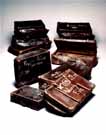
|
|
|

|

|

|

|
|
Click on an image to see a larger, more detailed picture.
|
|
|
|
|
| 1943: Death and Resistance |

|
pg. 444 |

|
|
|
|
| |
 Harry Baur, one of the most esteemed actors of the French and German cinemas, was among the Nazis' victims. Born in 1880, Baur established an international reputation, starring in such films as Les Miserables, in which he played Jean Valjean, The Life and Loves of Beethoven, and Crime and Punishment. While some stars of both stage and film fled Europe for the United States, others were unable or unwilling to do so. Accused of being an Allied agent, Baur died on April 20, 1943, while in Nazi confinement.
Harry Baur, one of the most esteemed actors of the French and German cinemas, was among the Nazis' victims. Born in 1880, Baur established an international reputation, starring in such films as Les Miserables, in which he played Jean Valjean, The Life and Loves of Beethoven, and Crime and Punishment. While some stars of both stage and film fled Europe for the United States, others were unable or unwilling to do so. Accused of being an Allied agent, Baur died on April 20, 1943, while in Nazi confinement.
Photo: Ullstein Bilderdienst
|
 Suitcases of Jews deported to Auschwitz-Birkenau, the camp's killing center, serve as a stark reminder that the victims had no notion of their impending doom. Orders for deportation came suddenly and swiftly. Jews hurriedly placed a few precious belongings in suitcases, wrote their names on the exteriors, and boarded trains to what they thought would be relocation centers somewhere in Eastern Europe. Upon boarding, people were separated from their belongings and told the items would be returned when they disembarked. Sorting through the belongings of Jews deported to Auschwitz and other death camps was a major and profitable undertaking.
Suitcases of Jews deported to Auschwitz-Birkenau, the camp's killing center, serve as a stark reminder that the victims had no notion of their impending doom. Orders for deportation came suddenly and swiftly. Jews hurriedly placed a few precious belongings in suitcases, wrote their names on the exteriors, and boarded trains to what they thought would be relocation centers somewhere in Eastern Europe. Upon boarding, people were separated from their belongings and told the items would be returned when they disembarked. Sorting through the belongings of Jews deported to Auschwitz and other death camps was a major and profitable undertaking.
Photo: State Museum of Auschwitz-Birkenau / United States Holocaust Memorial Museum Photo Archive
|
 Gerard Kornmann hid Dutch Jews on two occasions. In the end, however, an informer betrayed him, and he was arrested and shipped to the Sachsenhausen, Germany, concentration camp via the Vught, Netherlands, transit camp. Following the Allied invasion of Western Europe, his captors shipped him to Lübeck, Germany. He was on the Cap Arcona, which was among the four boats that the British bombed, assuming that the passengers were German, on May 3, 1945. Kornmann died in the attack. The irony of all this is painfully obvious, yet Kornmann's ultimate fate can be traced back to the informer--possibly a neighbor or even a "friend"--who betrayed him to the occupying authorities. The possible reason can only be guessed at.
Gerard Kornmann hid Dutch Jews on two occasions. In the end, however, an informer betrayed him, and he was arrested and shipped to the Sachsenhausen, Germany, concentration camp via the Vught, Netherlands, transit camp. Following the Allied invasion of Western Europe, his captors shipped him to Lübeck, Germany. He was on the Cap Arcona, which was among the four boats that the British bombed, assuming that the passengers were German, on May 3, 1945. Kornmann died in the attack. The irony of all this is painfully obvious, yet Kornmann's ultimate fate can be traced back to the informer--possibly a neighbor or even a "friend"--who betrayed him to the occupying authorities. The possible reason can only be guessed at.
Photo: Yoseph Schyveschuurder / United States Holocaust Memorial Museum Photo Archive
|
|

|

|

|

|
 April 19, 1943: The Warsaw Ghetto uprising begins. More than 2000 soldiers--SS, regular Army, and foreign troops--invade the ghetto. They attempt to liquidate the ghetto (40,000 inhabitants) on the eve of Passover, but about 700 Jews revolt. The Jews arm themselves with about 17 rifles, 500 pistols, and several thousand grenades and Molotov cocktails. The Jewish underground will fight the Nazis until the middle of May. The Polish underground will give only minimal help because of antisemitism prevalent among many. The Allies will neither publicize events nor try to help; See April 20, 1943.
April 19, 1943: The Warsaw Ghetto uprising begins. More than 2000 soldiers--SS, regular Army, and foreign troops--invade the ghetto. They attempt to liquidate the ghetto (40,000 inhabitants) on the eve of Passover, but about 700 Jews revolt. The Jews arm themselves with about 17 rifles, 500 pistols, and several thousand grenades and Molotov cocktails. The Jewish underground will fight the Nazis until the middle of May. The Polish underground will give only minimal help because of antisemitism prevalent among many. The Allies will neither publicize events nor try to help; See April 20, 1943.
|
|
|
|
|
| 1943: Death and Resistance |

|
pg. 444 |

|
|
The Holocaust Chronicle
© 2009 Publications International, Ltd.
|
|
